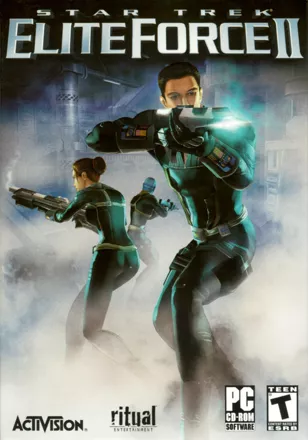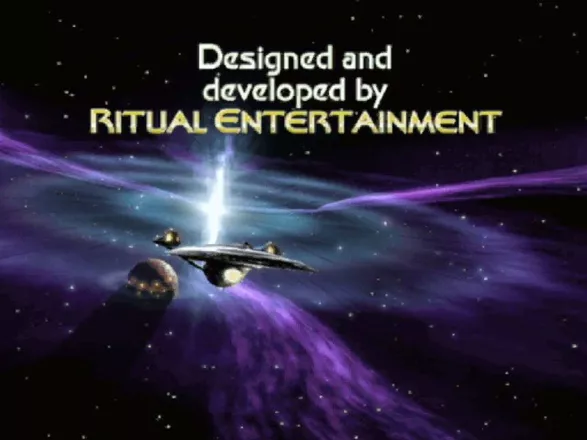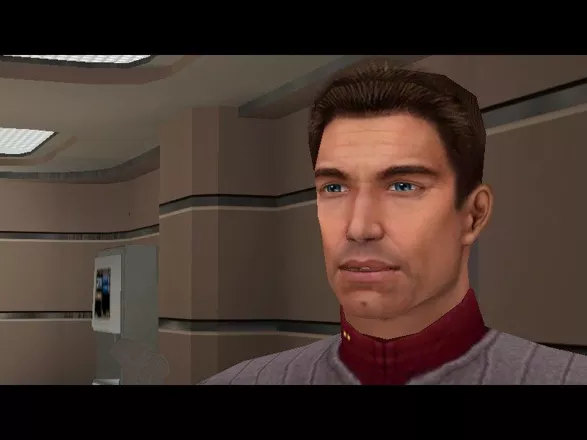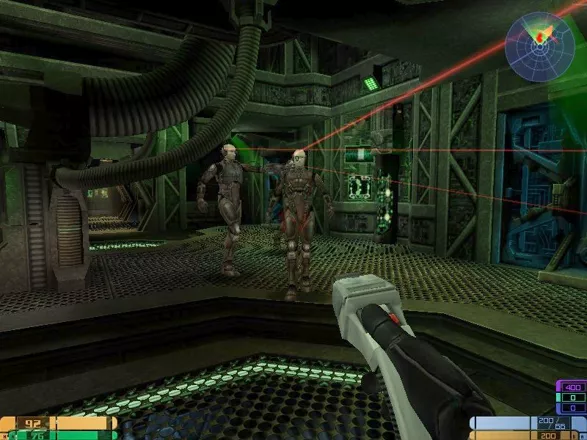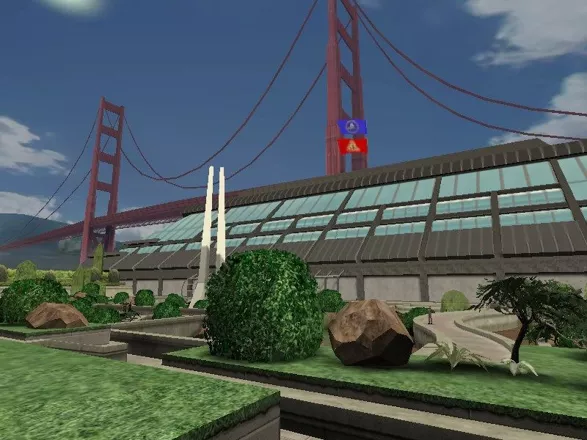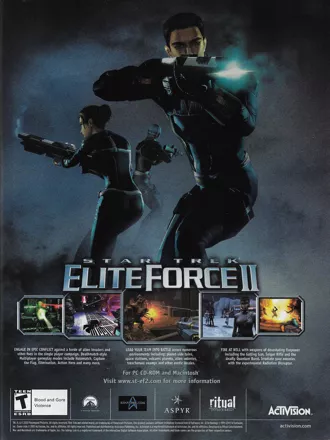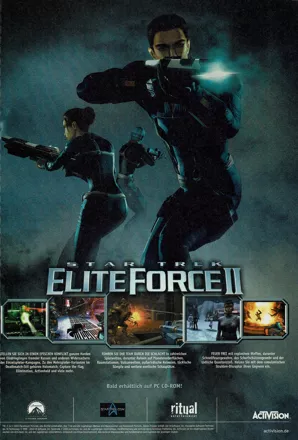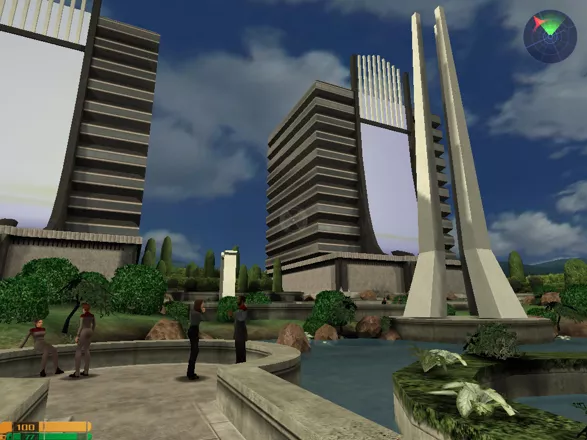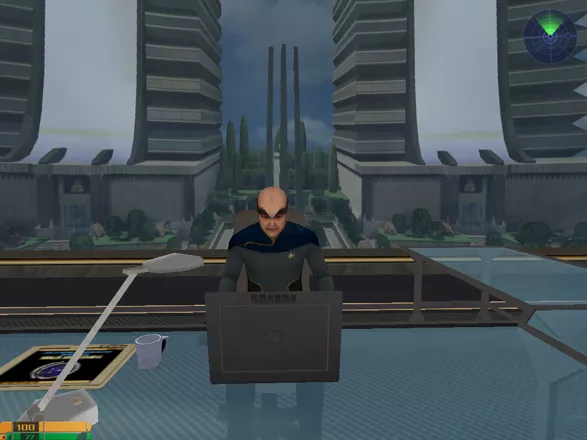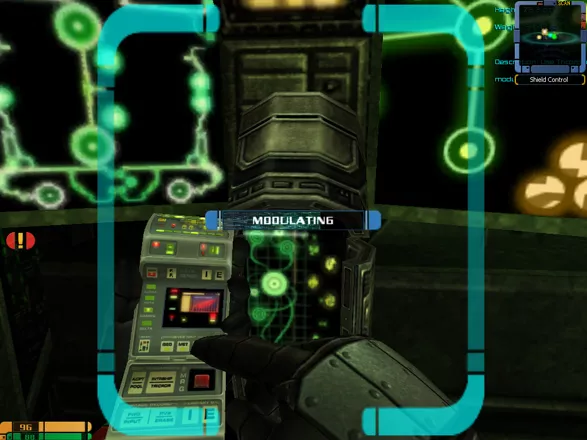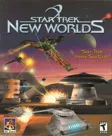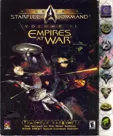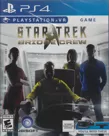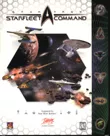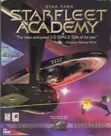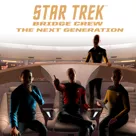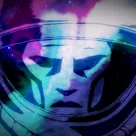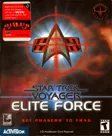Star Trek: Elite Force II
Description official descriptions
As the Starfleet Lieutenant Alexander Munro returns to Alpha Quadrant from a long voyage, the authorities consider the Hazard Team that he had commanded an unnecessary luxury, disbanding it and assigning Munro to teach small unit tactics at the Starfleet Academy. Two years later, Captain Picard contacts Munro and offers him to reassemble the Hazard Team on board his space ship, the USS Enterprise. Shortly afterwards, the ship receives a distress call from USS Dallas. Apparently, members of a mysterious alien race known as the Exomorphs have attacked the ship. As Munro is sent to rescue the crew members, he is reunited with an old friend, and has to face dangers graver than anything he has encountered so far...
Star Trek: Elite Force II is a sequel to Star Trek: Voyager - Elite Force. It is set in the Star Trek universe, chronologically overlapping with the last episodes of the Star Trek: Voyager series. Like its predecessor, it is a first-person shooter in which the player controls Alexander Munro (who can only be male in this sequel), who is usually aided by his AI-controlled teammates during exploration of the levels and combat.
Munro has fifteen weapons at his disposal, most of which have been ported from the previous game. Most of these futuristic, Star Trek-themed weapons are energy guns that have alternate firing mode. The tricorder reappears with a new function: the player must now actively use it in order to bypass security, participating in a power-routing mini-game, during which it is necessary to connect two nodes by manipulating a series of pipes.
During certain scripted events, the player can choose between two or more responses to a particular situation. These choices may affect the subsequent events and the level progression. There is also a possibility of a romantic involvement with one of the two female characters.
Spellings
- 星际迷航:精英力量II - Simplified Chinese spelling
Groups +
- 3D Engine: id Tech 3 with ÜberTools
- Character Feature: Actual person's looks and voice
- Gameplay feature: Dating / Romance
- Games with downloadable official map/level editors
- Games with official modding tools
- Games with officially released source code
- Genre: Arena shooter
- Inspiration: TV series
- Setting: Space station / Spaceship
- Star Trek licensees
- Star Trek: Elite Force series
Screenshots
Promos
Videos
See any errors or missing info for this game?
You can submit a correction, contribute trivia, add to a game group, add a related site or alternate title.
Credits (Windows version)
334 People (277 developers, 57 thanks) · View all
| Project Lead | |
| Technology Lead | |
| Design Lead | |
| Technical Director | |
| Software Engineer | |
| Additional Programming | |
| Creative Director | |
| Gameplay Director | |
| Multiplayer Director | |
| AI and Gameplay Programming Lead | |
| Gameplay Programmer | |
| Additional Design Contributions |
|
| Level Design Lead | |
| Level Designer, Lead Scriptor | |
| Level Designer | |
| [ full credits ] | |
Reviews
Critics
Average score: 78% (based on 39 ratings)
Players
Average score: 3.7 out of 5 (based on 33 ratings with 3 reviews)
Should appeal to genre fans and movie fans alike.
The Good
Like its predecessor, Elite Force II uses the Quake III engine which looks good but doesn't stand out when you consider the current games of the genre. However, it looks better than previous Star Trek games, and features convincing environments and effects, crisp textures, and fairly detailed character models. Elite Force II also uses a dynamic musical score which matches tempo with the current mood of the game. It works well and adds to the atmosphere. The original game excelled in story telling and Elite Force II doesn't disappoint. Make no mistake, this game is a pure shooter at heart - but it does have plenty of story sequences and a good plot with plenty of twists.
The Bad
Elite Force II's AI often leaves much to be desired. You'll often find your squad mates run into your line of fire and when you shoot them in the back, they don't seem to mind. That said, if you stroll across their line of fire, you may find yourself the subject of 'friendly fire'. Your enemies' maneuvers largely consist of dodging from side to side or running at you while shooting.
The Bottom Line
Elite Force II is a good, well-rounded shooter that should satisfy fans of similar games, as well as Star Trek fans looking to shoot first and ask questions later.
Windows · by Cyberzed (51) · 2003
Better than a book of Old Klingon Proverbs.
The Good
It takes a while after all the developer credits, but finally the Enterprise NCC-1701E whooshes around the screen with Jean-Luc Picard (Patrick Stewart) offering the famous split infinite speech and Elite Force II begins…
on the Voyager, stuck in a Borg Cube, back in the Delta Quadrant. Okay, apparently the Cube is the only thing preventing Voyager from getting home so the Hazard Team infiltrates the Cube, takes out some Borg, reroutes power and modulates shield frequencies and then they're back home…
to the Alpha Quadrant where Starfleet bureaucrats don't see the need for a Hazard Team when Away Teams do just fine, thank you very much. And the Hazard Team is quickly disbanded, leaving Lt. Alexander Munroe grounded at Starfleet Academy teaching small group tactics to eager students.
After this entire preamble, the game takes off when visiting Capt. Picard is impressed with the way Lt. Munroe and his Klingon student Korban (Tony Todd) chop up holo-Romulans with Bat'Leths. Picard reinstates the Hazard Team and none to soon, since the Enterprise receives a distress call from the Dallas—something about aliens chewing through their hull.
The Elite Force concept is the same in this entry—that the new life and new civilizations out there can be dangerous and it's not a bad idea having a heavily armored landing party equipped with personal photon torpedo launchers just in case things get hairy. Unlike the previous entry, I found this game more focused on the first-person shooter experience rather than the squad. Lt. Munroe often scouts ahead or is separated from the rest of the team and then rejoins them later. This works well, since my review of the last game notes, "the team AI did little other than jump into my line of fire or shoot me in the back. At best they drew fire away from me so I could flank around the enemies."
The game's story deals with the Federation's mediation of tensions between the unallied Attrexians, who are conveniently located near the Romulan neutral zone, and their servitors, the Idryll race. The Idryll are trying to prove that they were once an advanced race the Attrexians conquered and Idryll archaeologists have discovered ruins on one of their ancient home worlds. Unfortunately, the ruins have come to life and ancient factories are spewing forth exomorphs (the aliens chewing through the Dallas' hull).
Exomorphs, large bugs with built-in flight and weapons systems, comprise most of the game's enemies. Since they can chew through metal, they often pop out when least expected. Their AI is limited; they mostly charge into the attack. Other enemies prevent the game from being an all-out bug hunt, including the aforementioned Borg and other traditional Trek baddies. These exhibit more intelligence (well, not the Borg), ducking for cover and using appropriate weapons (beam vs grenade) at the appropriate times.
Munroe, the main character, is well-armed and armored, so the overwhelming odds are never too daunting. The standard Federation phaser remains the best fallback weapon in FPS history, since it's both high-powered and self-recharging. Munroe also comes across various energy rifles, shotguns, gatling guns, and plenty of other weapons.
The tricorder takes on more importance this time around, since Munroe has to reconfigure circuits and modulate frequencies. The tricorder has other modes which affect Munroe's view. A structural scan shows pulsing weak points he can destroy with a phaser blast. The gas scan shows vent leaks he can wield shut. Bio scans show sensor beams. Also, a final mission lets Munroe use his tricorder to call in air strikes.
Mission locations could be more varied, but variety within mission is exemplary. One sequence involving a raid on the Enterprise has Munroe rescuing different personnel, defending the warp core, restoring power, defending the Bridge (alongside Picard), and ends with Munroe on the ship's hull using a manual phase cannon against enemy vessels.
Elite Force II's final accomplishment is elevating Munroe from grunt status to real character. Munroe feels like another crew member, interacting with ship personnel and exploring different areas. The welcome addition of conversation options gives the player something to do between fragfests, allows the player to participate in a brilliant interrogation using the Ferengi Rules of Acquisition and works nicely with Munroe's love life.
The Bad
- There are a few clipping problems that cause Munroe to get stuck under boulders or in narrow crevices.
- Too many bugs (of the exomorph variety).
- It's the post-Nemesis Enterprise, so Capt. Picard and Lt. Barkley (Dwight Schultz) are the only familiar faces.
- I still don't think Elite Force is immersive enough. Starfleet Academy feels superficial and the Enterprise has limited deck access.
**The Bottom Line**
It takes too long to get started, but once it does, Elite Force II is a great ride. Whether you're just plowing through the levels or searching every nook for an elusive golden starship (used to unlock secret levels), the game has something to offer. What really impressed me was the great Star Trek feel to it. At higher resolutions, detail leaps off of panels and you can see the various Enterprise systems at work. It's also a good first-person shooter, providing the player with a wide range of weaponry against increasingly difficult opponents. It still feels too short, but this time, in a good way.
Windows · by Terrence Bosky (5397) · 2005
A colossal improvement over the first
The Good
When I first read about ‘Star Trek Voyager: Elite Force’ in PC Gamer four years ago, I was ecstatic that finally…FINALLY…there was going to be a Star Trek-themed FPS. Personally, I’d had enough of the Star Wars universe and Kyle Kataarn; I was ready to run around inside a Federation starship and shoot Borg. The game was finally released that summer to, in my opinion, mixed results. While the interface and environments were fairly immersive (the LCARS styled menu was excellent), and the cast of ‘Voyager’ was kind enough to lend their voices, the game seemed to be missing something. The plot of the game was laughable, it went by much too quickly, and oftentimes I couldn’t complete a mission because one of my squad mates got hung up on a wall. When I finished the game, I was left with a feeling of, “Is there nothing more?” (Pun intended)
Well, I’m happy to say that the sequel is, as I put it, a colossal improvement over the original. Not only have the graphics and AI improved, but the player is given a much larger arsenal of weaponry to choose from, the NPCs are less frustrating and more fun to interact with, and the game is longer with a more satisfying feeling of accomplishment. Also, the game was much more immersive this time around. Not to be cliché, but I genuinely felt like I was in a Star Trek film. In addition to some familiar enemies being brought back into the fold, two new races are introduced to the Star Trek universe. Hopefully they’ll be expounded upon in later installments.
As far as the plot goes, this alone makes the game worth it. In comparison with the first game, the sequel’s plot is very well thought out, and more…believable, if that makes any sense. It’s difficult to describe the plot without spoiling it, so I’ll leave you to stumble across the “Wow, that’s so cool!” moments.
The Bad
(Dork Mode is now active…non-Trekkers, skip this part if you wish)
One word: Vulcans. Why in god’s name were they so…emotional?! They sounded like humans when they spoke, which grated my nerves for the entire game. This is just WRONG. What a gargantuan insult to such a dignified race! The nerve of some voice actors!
(Dork Mode is now inactive)
The Bottom Line
If you want an immersive and rewarding Star Trek experience, look no further than ‘Elite Force II’. The original is definitely worth owning and playing for continuity purposes, but after this game you’ll hardly ever play the original. One does not even need to be a fan of the series to enjoy this game, although I know a couple of people who actually became fans of the shows after playing this game. It might happen to you, so be mindful.
Windows · by HandofShadow (49) · 2004
Trivia
Hazard Team member Korban is voiced by Tony Todd, who played Worf's brother Kurn on both Star Trek: The Next Generation and Star Trek: Deep Space Nine. He has also played an aged future version of Jake Sisko on Deep Space Nine and a Hirogen on Star Trek: Voyager.
Analytics
Upgrade to MobyPro to view research rankings and price history! (when applicable)
Related Sites +
-
Red Badge of Courage
An Apple Games article about the Macintosh version of Elite Force II (August, 2003).
Identifiers +
Contribute
Are you familiar with this game? Help document and preserve this entry in video game history! If your contribution is approved, you will earn points and be credited as a contributor.
Contributors to this Entry
Game added by Arvin Chandra.
Macintosh added by Corn Popper.
Additional contributors: Timo Takalo, Unicorn Lynx, Steve Hessel, Zeppin, Plok.
Game added August 30, 2003. Last modified January 19, 2025.


